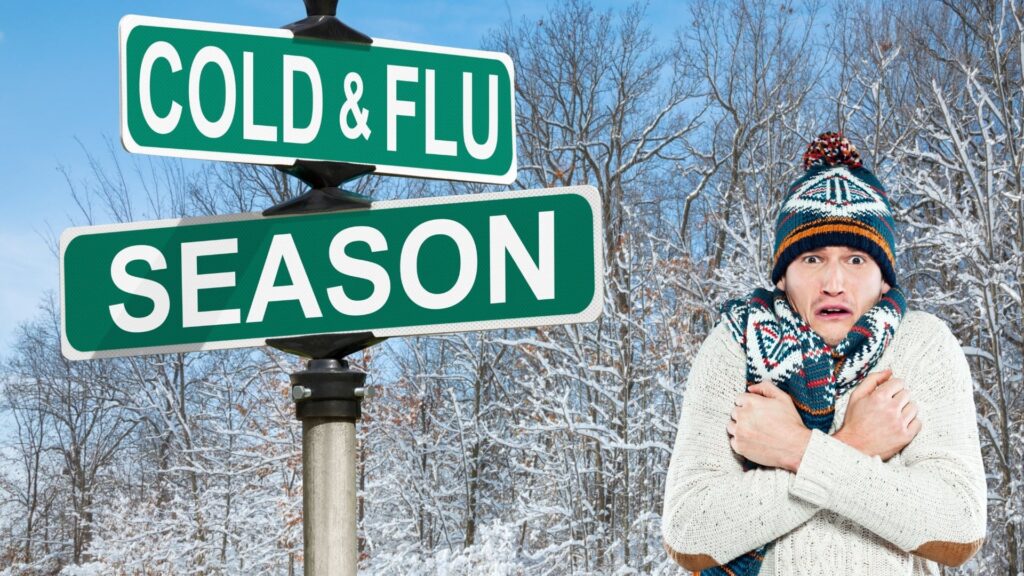As the chilly winds sweep in and the brightly coloured leaves show up, there’s no denying that the cold and flu season has arrived. It’s that time of the year when sniffles, coughs and tissue boxes become our strongest ally. However, every cloud has a silver lining; this is the ultimate guide to staying safe and healthy during this annual battle against threatening cold and flu viruses.
Imagine a winter where you can confidently walk into frosty mornings knowing you have the most effective strategies for repelling those pesky bugs. Imagine being surrounded by family, friends, and colleagues armed with knowledge, united in the commitment to staying well and preventing the spread of illnesses. Sounds good?
Today’s blog unravels the six secrets to a safe and thriving cold and flu season, from simple yet powerful prevention strategies to maintaining a clean environment to protect your loved ones. Make yourself comfortable with a cup of hot tea and embark on a journey to a winter brimming with wellness.
Understanding the Cold and Flu Season

As with any other emergency, we must understand what we face before diving into the best strategies to beat down and conquer the cold and flu season. The cold and flu season is an annual occurrence that impacts the pharmacy industry directly. It brings about a surge in respiratory illnesses. Understanding the nature of these viruses, how they are transmitted, and the timing of their peak is critical to navigating this period successfully.
- Viruses
Although the common cold and flu are caused by different viruses, they share similarities. Rhinoviruses mainly cause colds, whereas flu is caused by influenza viruses (such as influenza A and B). In both cases, these viruses compromise the respiratory system and usually cause coughing, sneezing, stuffy throat, and sore throat. However, influenza can be more severe and develop more complications in vulnerable people or those with weakened immune systems.
- Transmission
Both cold and flu viruses are highly contagious and can be transmitted through droplets expelled when an infected person coughs, sneezes or talks. These droplets can land on surfaces or be inhaled by nearby people, allowing the virus to enter the respiratory system. In addition, touching a contaminated surface and then touching your nose, mouth, or eyes can also promote infection.
Did you know that there are four ways diseases can be transmitted? According to the Comprehensive Guide for First Aid & CPR are,
- Direct Contact: When the body fluids of an infected person come in contact with another person. Example: AIDS or Hepatitis.
- Indirect Contact: When the germs stay on an object, another person gets in contact with it and then touches their nose, mouth or eyes. Example: Influenza
- Airborne Transmission: When the germs stay in the air and an individual breathes it. Example: Tuberculosis.
- Vector-Borne Transmission: When the germs are introduced into the body by an infected insect. Example: Lyme Disease or Malaria.
- Timing
Cold and flu seasons typically occur in fall and winter, but their peak varies yearly. Geographic location and climate influence their peak, but in most cases, we need to take preventive measurements from late August to March or April.

Stay Prepared This Cold Season!
6 Prevention Strategies to Stay Ahead in Cold and Flu Season
Prevention is key to staying safe when tackling the cold and flu season. Implementing effective strategies can reduce the risk of contracting these viral infections and minimize their spread. These are the top six strategies that our team thought of to incorporate into your daily routine;
1. Hand Hygiene
The top strategy to prevent malicious viruses is washing your hands frequently and thoroughly. This is an excellent strategy to remain safe and avoid spreading cold and flu viruses. Germs and bacteria can last on surfaces for up to 48 hours. Remember to wash your hands with soap and water for at least 30 seconds, especially before eating, using the washroom, and after coughing or sneezing. If you are busy and can not find a washroom, carry a 60% alcohol-based hand sanitizer in your first aid kit.
Guideline when washing your hands:
- Use warm water and mild soap
- Rub your hands with soap for at least 30 seconds. The friction with the soap suds is what removes germs.
- Wash your hands thoroughly – Scrub palms, wrists, between fingers, under the fingernails and the back of the hand.
- Dry your hands with a paper towel.
- Use the same paper towel as a barrier to close the faucet handle.

2. Breathing Code
Proper respiratory etiquette can help reduce the spread of cold and flu viruses. Facemasks can be both trendy and safe; also, when you cough or sneeze, use a tissue or elbow to cover your nose and mouth instead of your hands. Dispose of the used tissues promptly and practice proper hand hygiene to prevent cross-contamination.
3. Vaccination
Protect yourself and those around you with a flu shot. Annual influenza vaccines target significant influenza virus strains and reduce the risk of infections and the severity of the symptoms. In Canada, you can get the flu shot in pharmacies like Shoppers and Rexall. Encourage your loved ones to book an appointment and get their flu shot in time to remain safe.

4. Boosting Immunity
Besides getting a flu shot, maintaining a strong immune system is vital to prevent infection. Although experts suggest keeping a healthy lifestyle all year round, try to be more determined during fall and winter. Incorporate vegetables, fruits, whole grains and lean protein in your diet; keep an active routine and manage stress.
5. Maintaining a Clean Environment
Maintaining a clean environment is another crucial strategy to fight against cold and flu viruses. Make sure to clean and disinfect regularly all frequently touched objects, like doorknobs, light switches, countertops, phones and keyboards. For routine cleaning, use soap or detergent with water to remove dirt and germs, followed by an appropriate disinfectant recommended by health authorities.
On the other hand, if the weather is nice, open the windows to circulate fresh air to minimize airborne virus concentrations and improve air quality. Look at an air purifier with a HEPA filter to trap and filter particles such as viruses in the air.
6. Social Distancing
Finally but not least, try to reduce close contact with others, especially when they are sick. This means keeping a distance of at least 2 meters (6 feet) from individuals coughing, sneezing, or showing signs of illness. Remember to take a mask and face coverings whenever you go to crowded places, such as supermarkets and shopping malls. If you or someone in your house is feeling unwell, be mindful of the well-being of others and stay at home.
Register for First Aid Training
What to do if you get sick?

Even with the best efforts, you can still get sick during this challenging season. Familiarize yourself with the most common cold and flu symptoms, these are;
- Runny nose
- Coughing
- Sore Throat
- Sneezing
- Congestion
- Fever
- Body Aches
- Fatigue
- Headaches
Self-Care and Treatment
Staying at home and getting plenty of rest is always the best option if you don’t feel good. Stay adequately hydrated with fluids such as water, herbal teas and clear broths. Consult a pharmacist to get medication to help relieve symptoms and use disposable tissues when coughing and sneezing, as well as good hand hygiene to prevent the spread of the virus.
If someone in your family gets sick
If someone you love gets sick, designate one person as a caregiver and isolate the sick person in a separate room to limit close contact with others. Regularly clean and disinfect frequently touched surfaces around the ill person and avoid sharing personal items, such as towels, sheets, and food. If you have to provide medication, always follow the instructions on the label.
If someone starts experiencing difficulty breathing, chest pain, confusion, or bluish lips or face, seek immediate medical attention or call emergency services.
Become a Guardian of Health & Safety
Imagine having the skills and knowledge to not only protect yourself during illness or injury but also to help others. Whether providing primary care, responding to emergencies, or saving lives, Coast2Coast first aid courses equip you with valuable skills that can make a big difference in critical situations.
Coast2Coast offers comprehensive, interactive first-aid courses led by experienced instructors who guide you through real-world scenarios and teach essential techniques. From CPR and wound care to recognizing signs of distress and providing immediate care, these courses will help you become an effective first responder in your community.



















